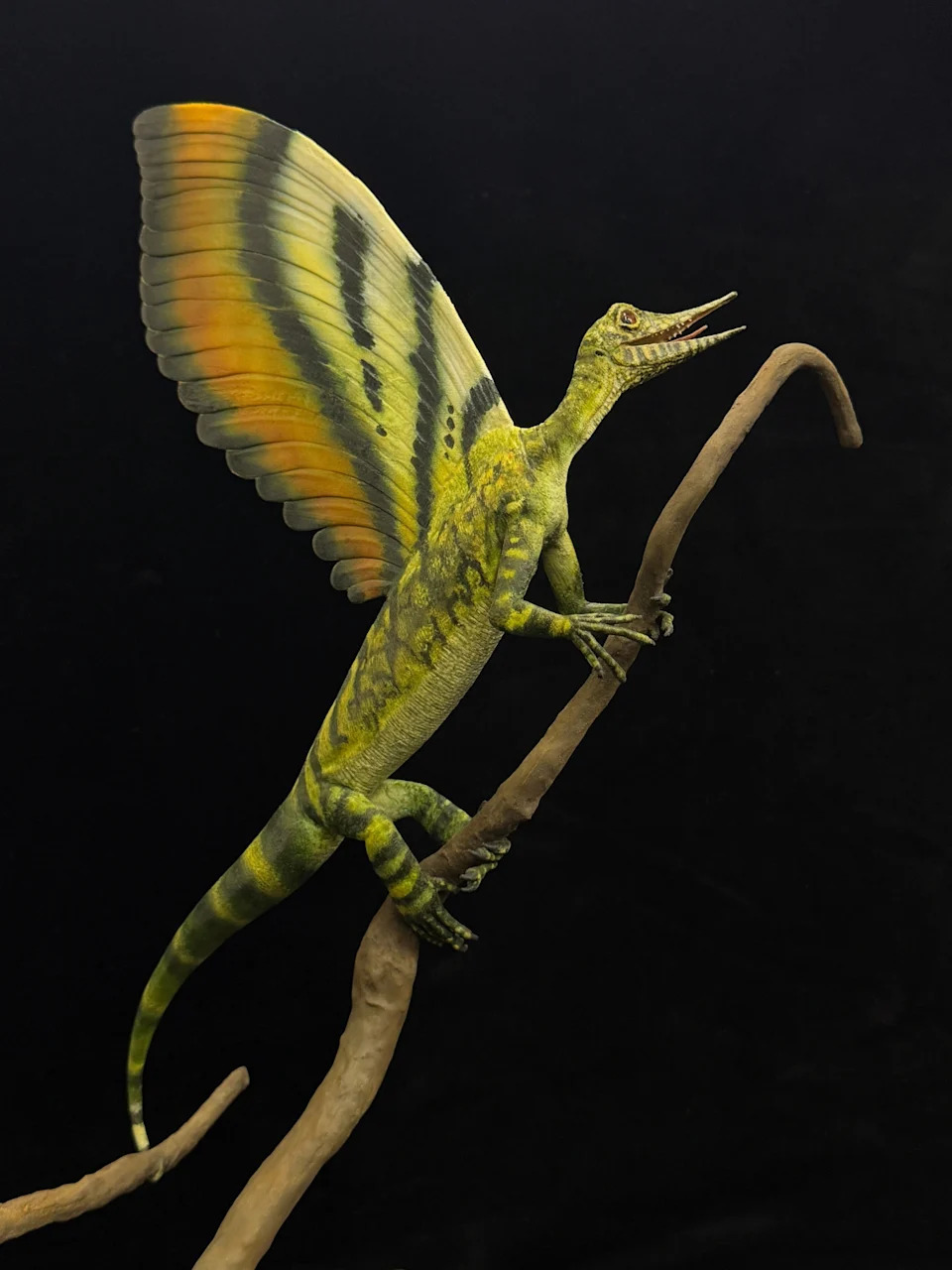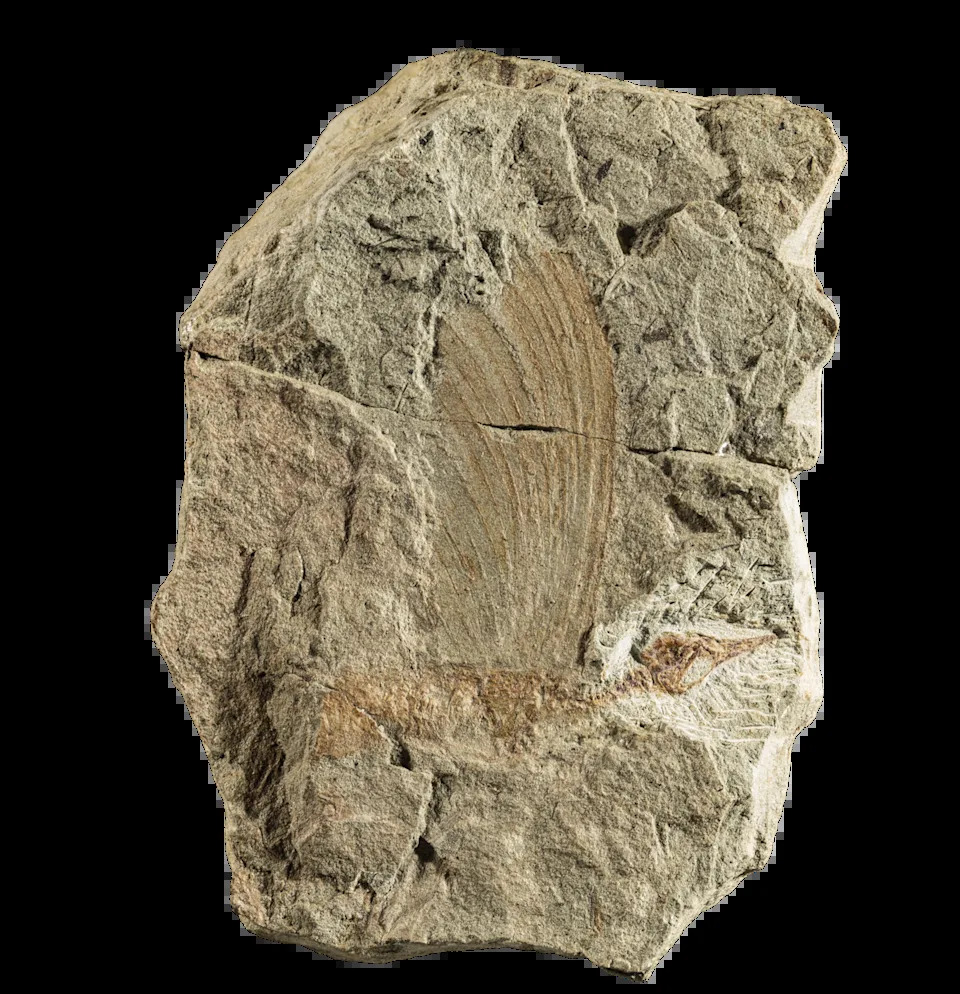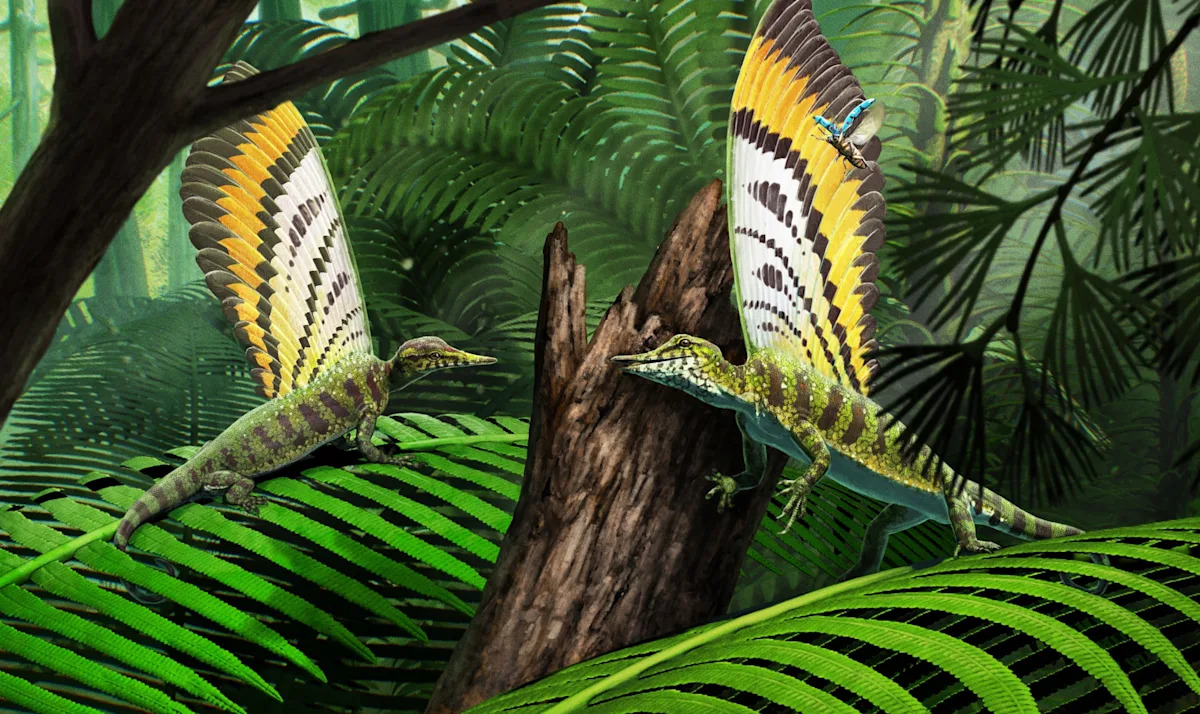Some 247 million years ago, a bizarre, six-inch-long reptile crept down a branch, its prehensile tail and feet clutching the bark like a monkey, and its narrow, birdlike face scanning its surroundings. On its back, an overlapping fan of stiff structures likely caught the light, vibrant with color. They looked very much like feathers, but were something entirely different as the reptile wasn’t related to birds or dinosaurs, and it existed a hundred million years before the first dinosaur took wing.
Researchers have long believed things like feathers and fur—complex structures which grow out of the skin, and can be used for insulation, sensing surroundings, visual displays and allowing flight—are largely unique to the lineages that gave rise to birds and mammals.
But now, a team of paleontologists have discovered a prehistoric reptile with a regal, plume-like crest that is unlike any previously-known integumentary appendage, things like horns, claws, and hair. The fossils show that evolutionary adaptations similar to feathers and fur were more widespread than previously thought.
“I’m stunned and flabbergasted,” says Steve Brusatte, a paleontologist at the University of Edinburgh who was not involved in the study. “It’s been a long time since I’ve been so blown away by a new fossil discovery.”
The finding, which was published Wednesday in Nature, also helps solve a decades-old paleontological mystery.
“There was always a distinction made between feathered dinosaurs and scaly reptiles,” says Stephan Spiekman, a paleontologist at the State Museum of Natural History in Stuttgart, Germany and an author on the paper. “And that’s too black and white of a story.”
A ‘miraculous reptile’
The specimens first came to light in May 1939, when private fossil collector Louis Grauvogel was prospecting quarries in the Triassic rocks of northeastern France. He found dozens of isolated structures he assumed to be fossilized fish fins, or insect wings, as well as the partial skeleton of a reptile. But when the Stuttgart State Museum of Natural History acquired his collection in 2019, Spiekman says, a museum researcher noticed faint ribs at the base of one of the fossilized structures. Carefully preparing away the rock, they found the preserved torso, neck and skull with the two-inch crest projecting out of the upper back. The structures and skeletons belonged to the same animal.
After studying the skeletal remains and over 80 specimens of isolated crests, the team chose the name Mirasaura grauvogeli, “Grauvogel’s miraculous reptile.” While the skeletons represent young animals, Spiekman says, the size of some of the isolated crests in the collection suggest adults could be well over a foot long.

A model of Mirasaura grauvogeli Illustration by SMNS/Tobias Wilhelm, Naturkunde Museum Stuttgart

The holotype of Mirasaura (State Museum of Natural History Stuttgart, Germany) showing the bird-like skull and crest along the back Photograph by Stephan Spiekman, Naturkunde Museum Stuttgart
His team identified Mirasaura as a member of a strange group of arboreal reptiles called drepanosaurs. Found in North America and Europe, drepanosaurs are sometimes compared to chameleons, Spiekman says. But they were much, much weirder: they had barrel-shaped bodies, humped shoulders, and large, forward-facing eyes on beaked, bird-like skulls. Many had opposable thumbs and monkey-like prehensile tails, with some species featuring a claw on the tail-tip.
“To me, the closest analogue is a pygmy anteater,” Spiekman says.
Reptile riddle solved
Mirasaura also provides the key to solving a long-standing Triassic riddle, says Michael Buchwitz, a paleontologist at the Museum of Natural History Magdeburg, in Germany, who was not involved with the study. In 1970, a Russian paleontologist published a paper about Longisquama, a fragmentary reptile with a spray of long, feather-like structures from Kyrgyzstan.
The discovery of Longisquama initially provided ammunition for researchers unhappy with the then-controversial theory that birds descended from dinosaurs. But as overwhelming evidence piled up showing the avian-dinosaur connection—including fossils showing that feathers and similar structures were widespread across dinosaurs and pterosaurs—nobody quite knew what to do with the enigmatic Longisquama, or where it belonged on the reptile family tree, Buchowitz says. Most elected to ignore it.
Now, however, the discovery of Mirasaura has allowed the Stuttgart team to finally identify Longisquama, too, as a long-lost drepanosaur. “The enigma is solved now,” says Buchowitz.
Remarkable convergent evolution
The overlapping plumes of Mirasaura and Longisquama’s strange crests do resemble feathers at first glance, Spiekman says, in that they’re most likely made out of keratin, a key structural protein that makes up everything from nails and scales to hair and feathers. “They stick up vertically away from the body and they’re long. This would have felt like a rigid, stiff feather.”
The team also found preserved melanosomes—pigment-producing cells—within the structures that looked more like those seen in bird plumage than reptile scales or mammalian hair, Spiekman says. But rather than the typical branching pattern of keratin filaments seen in true feathers, drepanosaur plumes seemingly formed in a single smooth sheet around their central ridge.
“What we have here is a remarkable example of convergent evolution, maybe the most stunning one I’ve ever seen,” says Brusatte. “They were not bird mimics. It was birds that mimicked them.”
Since drepanosaurs belonged to a much earlier evolutionary offshoot of the reptile family than the branch that gave rise to modern lizards, crocodiles and birds, Spiekman says, it suggests that the genetic adaptations for making these integumentary appendages arose early on in the vertebrate evolutionary tree.
It remains to be seen how widespread such feather-like crests were in the drepanosaur family, Spiekman says, and precisely how they’re formed. But the finding also opens the possibility that there are more feather-like structures to be found among other reptile families in the fossil record.
For Spiekman, flamboyant climbers like Mirasaura—with their monkey tails, chameleon feet, bird-like heads and feather-like crests—are “changing the picture of what a reptile is.”

